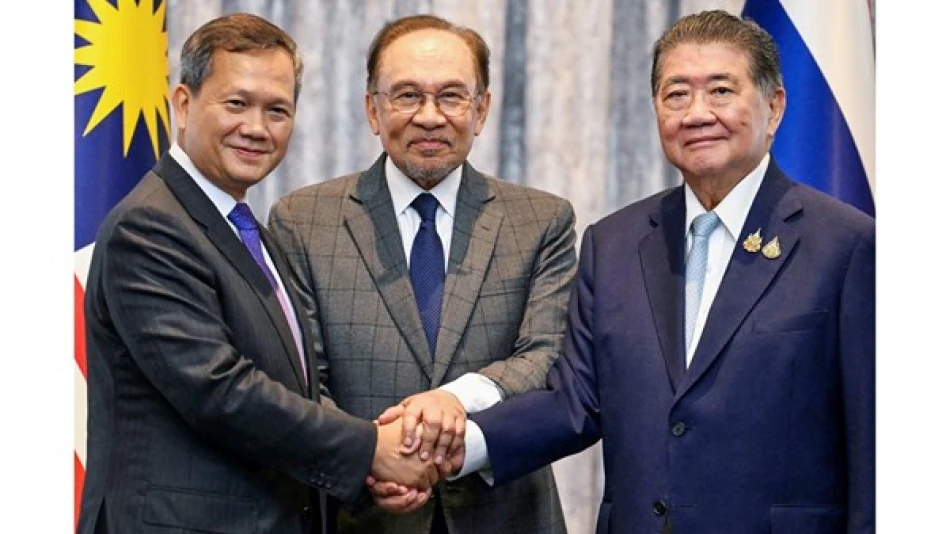
Malaysia Talks Aim to Resolve Thailand-Cambodia Border Tensions
Thailand-Cambodia Border Talks Resume Under Malaysian Mediation as U.S. Trade Pressure Forces Ceasefire
Thai and Cambodian officials met in Malaysia on Monday for critical border committee talks aimed at preventing renewed military clashes that killed dozens and displaced over 260,000 people. The negotiations, mediated by Malaysia as current ASEAN chair, come after U.S. economic pressure successfully forced a ceasefire last month, highlighting how trade leverage can resolve regional conflicts where diplomacy alone has failed.
Economic Diplomacy Succeeds Where Traditional Methods Failed
The July 28 ceasefire emerged not from regional diplomatic efforts, but from direct U.S. economic intervention. President Donald Trump's warning that America would refuse trade agreements with both nations if fighting continued proved decisive. Washington's subsequent tariff reduction from 36% to 19% on goods from both countries, effective August 1, demonstrates how economic incentives can rapidly de-escalate military tensions.
This approach mirrors successful U.S. trade-based diplomacy in other regions, where economic carrots and sticks have proven more effective than traditional diplomatic pressure. For Southeast Asian economies heavily dependent on U.S. market access, trade threats carry immediate political weight that military deterrence often lacks.
Strategic Venue Choice Signals Deeper Regional Dynamics
The decision to move talks from Cambodia to neutral Malaysian territory reveals the depth of mistrust between the neighbors. Malaysia's role as mediator strengthens its position as a regional power broker, similar to how Singapore has leveraged neutrality for diplomatic influence. This venue change also reinforces ASEAN's growing importance in managing intra-regional disputes, potentially setting precedents for future conflict resolution mechanisms.
Limited Scope Reflects Realistic Expectations
Monday's discussions deliberately avoided the decades-old territorial disputes over border enclaves that originally sparked the conflict. This tactical approach prioritizes immediate stability over comprehensive resolution, recognizing that addressing root causes requires longer-term diplomatic investment. Similar strategies have proven effective in other Asian border disputes, where confidence-building measures precede substantive territorial negotiations.
Cambodia's Internal Power Dynamics Complicate Peace Process
A surprise development emerged Monday evening when Cambodian King Norodom Sihamoni issued a royal decree allowing former strongman Hun Sen to work alongside his son, Prime Minister Hun Manet, on military and defense matters. The decree cited "serious violations and threats to Cambodian territorial integrity from Thai soldiers" as justification for this unprecedented power-sharing arrangement.
This move suggests Cambodia's leadership remains deeply concerned about Thai intentions despite the ceasefire. Hun Sen's return to defense decision-making could either strengthen Cambodia's negotiating position through experienced leadership or complicate talks by reintroducing a figure associated with decades of authoritarian rule and regional tensions.
Market and Regional Implications
The successful U.S. intervention offers important lessons for managing Southeast Asian conflicts. Regional stock markets and currencies had shown volatility during the fighting, particularly affecting tourism and cross-border trade sectors. The rapid stabilization following trade pressure demonstrates how economic interdependence can serve peace better than military deterrence.
For investors, this episode highlights both the fragility of regional stability and the effectiveness of economic leverage in crisis resolution. Companies with operations in both countries now face a more predictable environment, though underlying territorial disputes remain unresolved.
The Thailand-Cambodia talks represent a test case for whether economic incentives can create lasting peace frameworks in Southeast Asia's complex territorial landscape.
 Layla Al Mansoori
Layla Al Mansoori







